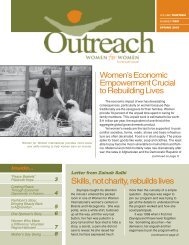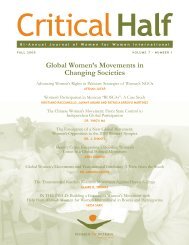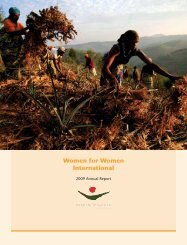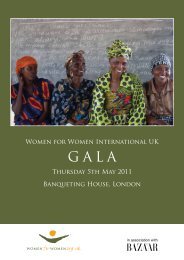Gender and Constitution Building - Women for Women International
Gender and Constitution Building - Women for Women International
Gender and Constitution Building - Women for Women International
Create successful ePaper yourself
Turn your PDF publications into a flip-book with our unique Google optimized e-Paper software.
co-ownership, the provision did broaden the definition<br />
of “family l<strong>and</strong>” to include “either l<strong>and</strong> where a family<br />
resides or obtains its sustenance.” 21 The provision also<br />
prevented a spouse’s registered objection to sale from<br />
lapsing after 60 days, as had been provided under the<br />
1998 L<strong>and</strong> Act. 22 Thus, women now have security of<br />
occupancy on family l<strong>and</strong> given an existing spousal relationship,<br />
but those rights terminate on divorce or death<br />
of the husb<strong>and</strong>, preserving the traditional patrilineal inheritance<br />
system.<br />
Without co-ownership rights, women also do not<br />
have the right to fully participate in l<strong>and</strong> management<br />
decisions, including how to use the l<strong>and</strong> <strong>and</strong> its resources.<br />
The Act is essentially “a sober attempt to provide ‘veiled<br />
co-ownership’ <strong>for</strong> limited l<strong>and</strong> rights in the manner of<br />
consent to the disposal of family l<strong>and</strong>.” 23 All the same,<br />
even though the family l<strong>and</strong> provision of the 2004 Act<br />
was significantly watered-down in the end, women recognized<br />
the additions as at least a small step <strong>for</strong>ward <strong>for</strong><br />
women’s property rights in Ug<strong>and</strong>a.<br />
Customary Practices<br />
Customary practices obstruct women’s ownership of<br />
property, as women in Ug<strong>and</strong>a generally are not permitted<br />
to inherit l<strong>and</strong> from their fathers or husb<strong>and</strong>s because<br />
of fears that family l<strong>and</strong> will be taken outside the<br />
clan when women marry or that widows will sell l<strong>and</strong> to<br />
non-clan members. 24 Thus, “a woman may have jointly<br />
acquired l<strong>and</strong> with her husb<strong>and</strong> <strong>and</strong> may have spent her<br />
entire adult life cultivating the l<strong>and</strong>, but she cannot claim<br />
ownership of the property.” 25 Further, women who are<br />
childless, single, widowed, disabled, separated, divorced<br />
or have only female children may have no access to l<strong>and</strong><br />
through a male relative <strong>and</strong> there<strong>for</strong>e have no means of<br />
subsistence. 26 Under customary practice, women do not<br />
inherit l<strong>and</strong> <strong>and</strong> may be stripped of their possessions,<br />
including l<strong>and</strong>, even after years of cultivation <strong>and</strong> improvement.<br />
Widows, in particular, must worry about eviction<br />
from their homes by in-laws upon their husb<strong>and</strong>s’<br />
death.<br />
Although statutory law does not “prohibit” women’s<br />
ownership of l<strong>and</strong>, the reality is that l<strong>and</strong> rights are a<br />
province of customary law. 27 In theory, statutory law<br />
trumps customary law, but socio-cultural practices effectively<br />
bar women from asserting their rights to property<br />
ownership. 28 Further, the absence of legislation on<br />
issues such as spousal co-ownership creates a roadblock<br />
<strong>for</strong> women’s ownership of property. Hence, a mere seven<br />
percent of the nation’s l<strong>and</strong> is owned by women, even<br />
though they make up half the population of the country.<br />
Conclusion<br />
Ug<strong>and</strong>a is to be commended <strong>for</strong> undergoing a significant<br />
economic <strong>and</strong> political trans<strong>for</strong>mation in the last<br />
two decades, including an evolution in its approach to<br />
women’s rights <strong>and</strong> gender equality. Ug<strong>and</strong>a has begun<br />
the process of overhauling its laws to reflect international<br />
norms <strong>and</strong> st<strong>and</strong>ards, <strong>and</strong> creating policies that put these<br />
laws into action. However, the conflict between the laws<br />
enshrined in the <strong>Constitution</strong> <strong>and</strong> customary practices<br />
must be negotiated to provide <strong>for</strong> genuine equality.<br />
Although Ug<strong>and</strong>a’s <strong>Constitution</strong> <strong>and</strong> some of its<br />
statutory laws may espouse gender equality, the customary<br />
law that is applied to a given situation often maintains<br />
a status quo that benefits men. Property rights in<br />
particular continue to be governed largely by customary<br />
law. Despite the many obstacles to overcoming customary<br />
practices adverse to women, NGOs <strong>and</strong> women’s<br />
organizations can create change through persistent lobbying<br />
of decision-makers <strong>and</strong> long-term commitment to<br />
goals. <strong>Women</strong> should also take advantage of national affirmative<br />
action measures that integrate women into<br />
local governance structures where they can bring special<br />
attention to gender issues. 29<br />
CARA DILTS received her M.A. in international development<br />
<strong>and</strong> J.D. from the University of Denver. She holds a B.A. in<br />
international relations, with a minor in women’s studies, from<br />
Duquesne University. In 2003, she conducted field interviews <strong>and</strong><br />
did extensive research on gender mainstreaming <strong>and</strong> women’s rights<br />
in Ug<strong>and</strong>a. Ms. Dilts is currently a Research Fellow <strong>and</strong> LL.M.<br />
c<strong>and</strong>idate at the National University of Singapore.<br />
BIBLIOGRAPHY<br />
Ug<strong>and</strong>a <strong>Constitution</strong> (1995).<br />
United Nations. “Convention on the Elimination of All Forms of Discrimination<br />
against <strong>Women</strong>.” September 3, 1981. U.N. Doc. A/34/46.<br />
United Nations. “<strong>International</strong> Covenant on Civil <strong>and</strong> Political Rights.”<br />
March 23, 1976. U.N. Doc. A/6316 (1966), 999 U.N.T.S. 171.<br />
United Nations. “<strong>International</strong> Convenant on Economic, Social, <strong>and</strong><br />
Cultural Rights.” January 3, 1976. U.N. Doc. A/6316 (1966), 993<br />
U.N.T.S. 3.<br />
United Nations Economic <strong>and</strong> Social Council. Agreed Conclusions on<br />
Mainstreaming a <strong>Gender</strong> Perspective into all Policies <strong>and</strong> Programs of the United<br />
Nations System. New York: ECOSOC, 2004.<br />
United Nations Economic <strong>and</strong> Social Council. Mainstreaming a <strong>Gender</strong> Perspective<br />
into all Policies <strong>and</strong> Programmes in the United Nations System. New<br />
York: ECOSOC, 2001.<br />
Organization of African Unity. “African [Banjul] Charter on Human <strong>and</strong><br />
Peoples’ Rights.” June 27, 1981. OAU Doc. CAB/LEG/67/3 rev. 5,<br />
21 I.L.M. 58 (1982).<br />
Fourth World Conference on <strong>Women</strong>. Beijing Declaration <strong>and</strong> Plat<strong>for</strong>m of<br />
Action. Beijing: FWCW, 1995.<br />
CRITICAL HALF 37







